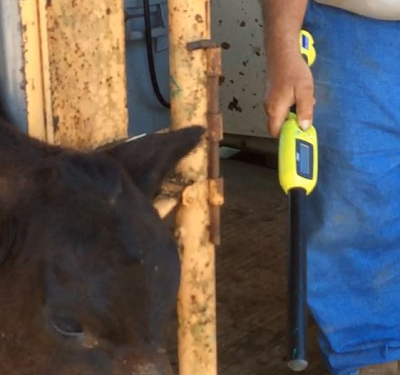For dairy businesses that have a large number of cows to identify quickly, Radio Frequency Identification (RFID) or Electronic Identification (EID) tags offer a straightforward option.
The EID tag is a compact button containing an embedded microchip that attaches to a standard cattle tag. Tags and chips share the same 15-digit identifying number for easy visual and automated tracking.
Workers in the dairy industry use a portable RFID reader to scan the ear tag. This reader gives power to the device and reads the number that is encoded in the microchip. After that, the reader sends the data to a portable computer that contains all the information about each particular cow. The tags are long-lasting, and as long as they are positioned correctly, they should remain on the animal for its entire life.
Electronic ID for Cattle Pros
Identification of cattle has both visual and management advantages. Cattle ear tags allow you to distinguish between different cows in your herd with ease. Additionally, being able to track an animal's past behavior and productivity enables you to identify which animals are performing well.
It provides an additional method of animal identification. Visual tags can be misplaced, hooked on a fence, and so on, but EID tags are compact and built for excellent retention rates.
Scanning the tag using a reader in the chute is faster than reading a visual tag or tattoo number, which requires the animal to stand perfectly still.
Scanning EID tags, as opposed to manually documenting an ear tag number, offers substantial time savings and reduces the likelihood of making mistakes. The EID tag can be scanned even when the cow is being labored or loaded into a trailer.
Electronic identification can be very helpful for cattle ranchers who need to monitor their herds in transit or at feedlots. Additionally, it can aid in maintaining records and keeping track of illnesses. Electronic identity is required for all livestock in some nations, such as the European Union.

Electronic ID for Cattle Cons
Before instituting electronic identification (EID), cattle producers should carefully consider its cons. The following are some drawbacks of electronic cattle identification:
High cost
The implementation of EID calls for a large financial investment in computer hardware and software as well as in training. Despite the fact that the cost of electronic tags has declined over time, some producers may still find the whole cost of using EID to be unaffordable.
Compatibility issues
There is a possibility that EID systems will not be compatible with the software or databases that are already in use, which will bring up extra difficulties in managing data.
welfare of animals
The technique of inserting an electronic identification (EID) tag into the ear of a cattle animal is quite similar to the procedure of inserting a conventional ear tag. A specialized tool is used to place the ear tag in the animal's ear, and the animal may experience some discomfort during this process. On the other hand, some animals may show signs of brief discomfort or sensitivity at the site of the tag placement, such as rubbing or scratching their ears.









0 Comments